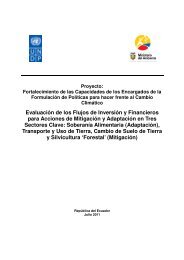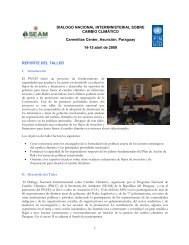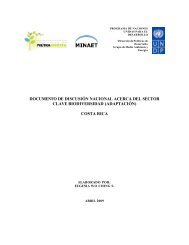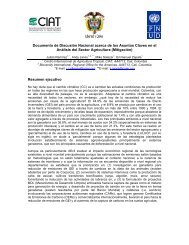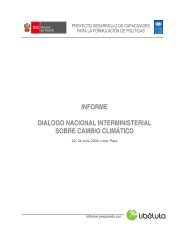View Publication - UNDPCC.org
View Publication - UNDPCC.org
View Publication - UNDPCC.org
Create successful ePaper yourself
Turn your PDF publications into a flip-book with our unique Google optimized e-Paper software.
7 Cannady — Access to Climate Change Technology by Developing Countries: A Practical Strategy<br />
A patent pool is an agreement by multiple<br />
patent holders to share intellectual property<br />
among themselves or to license a<br />
portfolio of patents as a package to outsiders<br />
[author’s italics]. 30<br />
Another definition states:<br />
A patent pool is an arrangement among<br />
multiple patent holders to aggregate<br />
their patents. A typical pool makes all<br />
pooled patents available to each member<br />
of the pool. Pools also usually offer<br />
standard licensing terms to licensees who<br />
are not members of the pool. In addition,<br />
the typical patent pool allocates a<br />
portion of the licensing fees to each<br />
member according to a pre-set formula or<br />
procedure [author’s italics]. 31<br />
The word “typical” does not apply well to<br />
patent pools: there is great variation in the<br />
purpose and operational rules of patent pools.<br />
What is noticeable is that both definitions<br />
make clear that patent pools are formed by<br />
“patent holders”, meaning parties that own<br />
patents.<br />
The term “commons” has no legal definition<br />
but connotes the desirable civic quality of a<br />
public park that charges no admission fees and<br />
is open to all members of the public. The term<br />
may be misleading, just as the word “open”<br />
is sometimes misleading, because it suggests<br />
that the commons contains only public-domain<br />
technology or is accessible without payment.<br />
What is important is to examine the specifics of<br />
any proposed pooling or commons arrangement<br />
in order to understand its operation and<br />
rules.<br />
The following are different types of arrangement<br />
that may be described as patent pools<br />
or commons:<br />
• Standards consortium: The consortium<br />
(group of companies in the same technical<br />
field, both competitors and noncompetitors)<br />
is formed with the objective<br />
of promoting and evolving an agreed-upon<br />
technical standard (e.g. the Institute of<br />
Electrical and Electronics Engineers’ IEEE<br />
standard). Members agree to license to<br />
all other members all patents necessarily<br />
infringed by a product complying with the<br />
technical standard (“essential patents”).<br />
The licence fees and other terms may be<br />
established by the consortium agreement<br />
or the members may agree to negotiate<br />
licences to other members with fair and<br />
reasonable non-discriminatory royalties<br />
(FRAND) or reasonable non-discriminatory<br />
royalties (RAND). Each member must<br />
negotiate with other members for how<br />
FRAND or RAND will be defined in any<br />
particular case.<br />
• Standards consortium with an administrative<br />
body: This is the same as a<br />
standards consortium, but licensing is<br />
managed by a corporate entity formed<br />
for this purpose. All members license<br />
their “essential” patents to the entity<br />
and it licenses out to the members. The<br />
administrative entity may license to nonmembers<br />
upon terms that can be higher<br />
than or different from terms to members.<br />
In other words, non-members do not get<br />
the same deal that members get in most<br />
cases because they are not contributing<br />
IP or other support to the consortium.<br />
• Cross-licence: Several companies join<br />
together to cross-license each other’s<br />
patents by a written agreement. No new<br />
corporate entity is formed. No agreement<br />
is made with respect to whether patents<br />
will be licensed to outsiders (non-parties<br />
to the agreement) and such licences are<br />
left up to each party. The cross-licences<br />
may be royalty-free, or one party with a<br />
relatively smaller or less valuable patent<br />
portfolio may pay a royalty to another<br />
with a more valuable portfolio. This kind<br />
of agreement is motivated by the desire<br />
to avoid litigation risk among companies<br />
with relatively equal bargaining power. (A<br />
covenant not to sue is a licence.) A crosslicence<br />
arrangement among multiple<br />
parties may also be motivated by a desire







